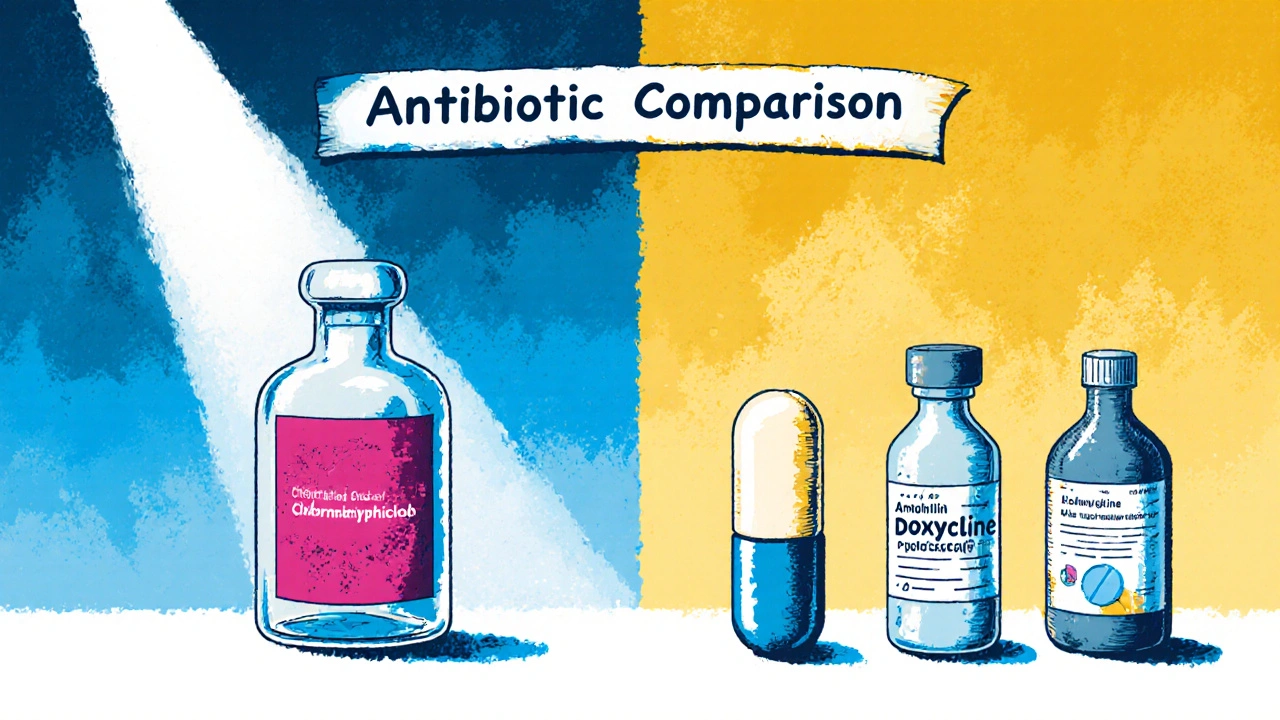When a doctor prescribes Chloramphenicol is a broad‑spectrum antibiotic that has been used for more than 70 years. Despite its effectiveness against a variety of bacteria, clinicians often ask: are there safer or more convenient options? This guide walks through the most common Chloramphenicol alternatives, comparing how they work, when they’re recommended, and what risks you should watch out for.
Key Takeaways
- Chloramphenicol is effective but carries serious blood‑related side effects and is limited to specific infections.
- Azithromycin, amoxicillin, doxycycline, and ciprofloxacin cover many of the same infections with better safety profiles.
- Choosing the right antibiotic depends on pathogen, site of infection, patient age, pregnancy status, and local resistance patterns.
- Always follow dosing guidelines and monitor for adverse reactions, especially with older drugs like chloramphenicol.
- Consult local WHO or FDA recommendations for up‑to‑date resistance data.
What Makes Chloramphenicol Unique?
Chloramphenicol works by binding to the 50S ribosomal subunit, halting bacterial protein synthesis. It’s active against many gram‑negative and gram‑positive bacteria, plus some anaerobes and atypical organisms. Historically, it was a go‑to drug for typhoid fever, meningitis, and rickettsial infections. However, two drawbacks limit its use today:
- Bone‑marrow suppression: rare but potentially fatal aplastic anemia can appear weeks after treatment.
- Gray baby syndrome: newborns lack the enzymes to metabolize the drug, leading to accumulation and severe toxicity.
Because of these risks, many health authorities recommend reserving chloramphenicol for cases where first‑line agents fail or are contraindicated.
Why Look for Alternatives?
Modern medicine offers a broader toolbox of antibiotics with comparable spectra but fewer severe side effects. The main reasons clinicians switch away from chloramphenicol are:
- Safer side‑effect profiles (especially in children and pregnant women).
- Simpler dosing regimens - many alternatives are once‑daily.
- Better coverage of current resistant strains, as resistance to chloramphenicol has risen in many regions.
- Regulatory restrictions - some countries have removed chloramphenicol from routine formularies.

Quick Reference Comparison Table
| Antibiotic | Spectrum | Typical Indications | Dosage Form | Common Side Effects | Resistance Concerns |
|---|---|---|---|---|---|
| Chloramphenicol | Broad (Gram‑+, Gram‑‑, anaerobes) | Typhoid, meningitis, rickettsial disease | Oral, IV | Aplastic anemia, gray‑baby syndrome | Increasing in low‑resource settings |
| Azithromycin | Gram‑+, some Gram‑‑, atypicals | Respiratory infections, STIs, traveler's diarrhea | Oral, IV | GI upset, QT prolongation | Low to moderate; still first‑line for many |
| Amoxicillin | Gram‑+, some Gram‑‑ (with clavulanate) | Otitis media, sinusitis, UTI | Oral | Rash, GI upset | High for H. influenzae, moderate for E. coli |
| Doxycycline | Broad (Gram‑+, Gram‑‑, rickettsia) | Lyme disease, acne, malaria prophylaxis | Oral | Photosensitivity, esophagitis | Emerging in some STIs |
| Ciprofloxacin | Gram‑‑ (Pseudomonas), some Gram‑+ | UTI, abdominal infections, traveller’s diarrhea | Oral, IV | Tendon rupture, CNS effects | Rising in E. coli and Pseudomonas |
Deep Dive into Each Alternative
Azithromycin
Azithromycin, a macrolide, binds to the 50S ribosomal subunit but at a different site than chloramphenicol. It’s praised for its long half‑life, allowing a three‑day course for many infections. Compared with chloramphenicol, it rarely causes bone‑marrow suppression, making it safer for children and pregnant women. However, it can prolong the QT interval, so patients with cardiac arrhythmias need monitoring.
Amoxicillin
Amoxicillin is a beta‑lactam antibiotic that inhibits cell‑wall synthesis. It’s the workhorse for ear, sinus, and bladder infections. Its safety record is excellent - the most common issue is a mild rash. Resistance is growing in some regions, especially for beta‑lactamase‑producing organisms, which is why doctors sometimes pair it with clavulanic acid.
Doxycycline
Doxycycline belongs to the tetracycline class. It’s effective against a wide array of bacteria, including those that cause Lyme disease and certain rickettsial infections-areas where chloramphenicol was once a fallback. The drug is taken once daily and is generally well‑tolerated, but patients should avoid excessive sun exposure because of photosensitivity.
Ciprofloxacin
Ciprofloxacin is a fluoro‑quinolone that interferes with DNA gyrase. It’s especially good for urinary‑tract and gastrointestinal infections caused by gram‑negative bacteria. While it avoids the hematologic toxicity of chloramphenicol, it carries a risk of tendon rupture, particularly in older adults and those on steroids.

How to Choose the Right Antibiotic
Pick an alternative based on four practical factors:
- Pathogen profile: Use culture data when possible. For unknown infections, azithromycin or doxycycline cover many atypicals.
- Patient characteristics: Avoid chloramphenicol in children < 12 months, pregnant women, and patients with liver disease. Doxycycline is contraindicated in pregnancy, while azithromycin is safe.
- Site of infection: Blood‑brain barrier penetration matters for meningitis - chloramphenicol still has good CSF levels, but high‑dose ceftriaxone is preferred now.
- Local resistance data: Reference the latest WHO or FDA surveillance reports.
When in doubt, start with a narrow‑spectrum drug (e.g., amoxicillin for suspected streptococcal pharyngitis) and broaden only if cultures dictate.
Safety Monitoring and Common Pitfalls
Even the safest antibiotics can cause trouble if misused. Here are quick checks:
- Allergies: Document any prior reactions; cross‑reactivity is common among beta‑lactams.
- Drug interactions: Azithromycin + statins may raise muscle toxicity risk; ciprofloxacin + antacids reduces absorption.
- Therapeutic drug monitoring: Not usually needed for the alternatives listed, but chloramphenicol levels are sometimes checked in severe infections.
- Follow‑up labs: For chloramphenicol, CBC weekly for the first two weeks; for fluoro‑quinolones, watch for tendon pain.
Frequently Asked Questions
Is chloramphenicol still used in the United States?
It is available only for serious infections where no safer alternatives exist, mainly through restricted hospital formularies. Over‑the‑counter use is prohibited.
Can I switch from chloramphenicol to azithromycin mid‑treatment?
Yes, if the infection is responding and susceptibility data support azithromycin. Always coordinate the switch with a clinician to avoid gaps in coverage.
What is the main side effect that makes doctors avoid chloramphenicol?
Aplastic anemia, a rare but often fatal bone‑marrow failure, can appear weeks after therapy and has no antidote.
Is doxycycline safe for pregnant women?
No. Doxycycline belongs to the tetracycline class, which can affect fetal bone growth and teeth discoloration. Azithromycin is the preferred macrolide in pregnancy.
How does local resistance affect my choice?
If local data show high resistance to macrolides, clinicians may favor a beta‑lactam or fluoro‑quinolone instead. Checking the latest WHO antimicrobial resistance report is a good habit.
Bottom line: chloramphenicol still has a place in medicine, but for most everyday infections, one of the newer alternatives offers similar coverage with far fewer risks. Always discuss your specific situation with a healthcare professional before swapping or stopping any antibiotic.








13 comments
Tim Blümel
Reading through the comparison really makes you appreciate how far antimicrobial therapy has come 🌱. While chloramphenicol was once a hero, its shadow of aplastic anemia looms large. The newer alternatives let us treat infections with far fewer worries about the blood. It’s like swapping a horse‑drawn carriage for a modern electric car – same destination, smoother ride. Keep the conversation going, and let’s champion safety first! 😊
Joanne Ponnappa
Great concise rundown!
Emily Collins
When I first encountered the name chloramphenicol, it felt like reading about a relic from a bygone era, a drug shrouded in both reverence and dread. Its broad‑spectrum promise once painted it as a knight in shining armor, marching into wards to vanquish typhoid, meningitis, and rickettsial foes. Yet, the very potency that made it a savior also concealed a silent assassin: bone‑marrow suppression that could surface weeks after the last dose. The specter of gray‑baby syndrome haunted newborns, a tragic reminder that not all miracles are without cost. In contrast, azithromycin arrives with a gentle touch, offering once‑daily dosing and a lower risk of hematologic calamities. Amoxicillin, the workhorse of primary care, carries a reputation for mild rashes, a price many find acceptable for ear infections. Doxycycline, with its sun‑sensitive side effects, still stands tall against Lyme disease and certain rickettsial challenges. Ciprofloxacin, though powerful against gram‑negative threats, warns of tendon rupture, especially in the elderly. Each alternative, while sparing the blood, introduces its own set of cautions, demanding a nuanced balance. The clinician’s art lies in weighing these trade‑offs against local resistance patterns, patient comorbidities, and the urgency of the infection. As resistance to chloramphenicol climbs in low‑resource settings, its role dwindles further, relegated to a reserve drug for the most stubborn cases. The modern antimicrobial arsenal, though richer, compels us to stay vigilant, lest we repeat past mistakes. Ultimately, the story of chloramphenicol is a cautionary tale of progress, reminding us that potency must be coupled with prudence. Let us honor its legacy by using its successors wisely, preserving both efficacy and safety for generations to come.
Tiffany Davis
That dramatic overview really captures the ethical tightrope we walk. Your point about local resistance data is spot‑on; I’ve seen labs where azithromycin resistance spiked dramatically. It’s crucial we keep those surveillance reports close at hand when choosing a regimen.
Don Goodman-Wilson
Oh great, another “comprehensive guide” telling us to ditch chloramphenicol. As if older drugs are always the villain.
Sajeev Menon
i think its worth noting that in many rsrc limited area, chloramphenicol is still more accesible than the pricier alternatives. also, some clinicians rely on its cns penetration when dealing w/ meningitis cases.
Emma Parker
Just wanted to say thanks for the clear table, super helpful!
Joe Waldron
Indeed, the table is well‑structured; however, note that dosage adjustments for renal impairment are crucial!! Also, be aware of drug‑drug interactions!!!
Wade Grindle
The overview feels balanced, covering both efficacy and safety.
Benedict Posadas
Totally agree! 🙌 It's like you gave us a cheat‑sheet for antibiotics-big thanks!! btw watch out for typos in the table, i think the doxycycline side‑effects column got mixed up lol.
Jai Reed
While the enthusiasm is appreciated, clinicians must enforce strict monitoring protocols for any antibiotic switch.
Sameer Khan
From a pharmacodynamic perspective, the distinction between bacteriostatic and bactericidal agents is pivotal. Chloramphenicol’s static nature can be advantageous in certain intracellular infections, yet it also demands synergistic partners when rapid eradication is needed. The table rightly highlights CSF penetration for chloramphenicol, a trait not shared by many beta‑lactams. However, the risk‑benefit calculus must incorporate patient‑specific factors like hepatic function and genetic predispositions to drug‑induced aplasia. In resource‑constrained environments, the cost‑effectiveness of older agents cannot be dismissed outright.
Kiara Gerardino
One cannot ignore the moral responsibility clinicians bear when prescribing potent drugs. To gamble with a patient’s marrow for the sake of convenience borders on ethical negligence. Let us champion therapies that honor life, not endanger it.